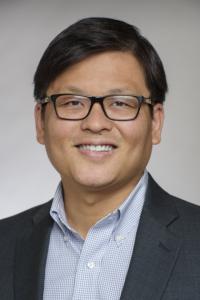
Chang Lee Seeks Novel Solutions for TMJ Disorder
A persistent ache in the jaw. Difficulty opening the mouth. A popping sound when the mouth is opened too wide. Dentists know well that these are some of the many symptoms associated with dysfunction of the temporomandibular joint, commonly known as TMJ or lockjaw. This is a degenerative disorder that affects some 10 million Americans. A wide range of conditions can cause dysfunction in the jaw joint and associated muscles, but all patients with TMJ dysfunction share the risk of long-term damage to the joint to varying degrees, and dentists can only treat symptoms, or, as a last result, perform surgery as an attempt to correct the damage.
Chang Lee, PhD, is working to develop a completely new approach to treatment by regenerating the TMJ disc using the patient’s own stem cells. TMJ disc displacement is a prominent condition associated with persisting TMJ pain and one that could ultimately lead to osteoarthritis. Lee and his collaborators have devised a new method that harnesses the body’s own healthy stem cells to regenerate tissue in the damaged area.
“Traditionally, when you work with stem cells, you must remove them from the body and work on them in vitro in order to rebuild tissue. But this method consequently can damage the cell, destroy its ability to heal or may result in other problems such as contamination,” says Dr. Lee, who is an associate professor of craniofacial engineering at Columbia University College of Dental Medicine (CDM). “We’ve developed a novel way to instead redirect stem cells in vivo—in a person’s own body— into the unhealthy or affected areas for tissue regeneration.”
To regenerate the tissue of the damaged TMJ disc, Lee and his group have developed a spatiotemporal delivery system, a tightly controlled system that recruits and guides nearby stem cells into the affected area. The stems cells are redirected to an embedded 3D-printed bioscaffold of the disc, and the cells regenerate the damaged tissue inside the scaffold, fully restoring the TMJ disc.
“What we are doing is stimulating a body’s own stem cells for tissue regeneration,” he said.
Lee envisions this method can be used to regenerate the TMJ disc and also damaged knee joints. Lee and his team have recently proven their method in an animal model. Their study resulted in full recovery of the model’s damaged TMJ disc in four weeks.
Lee’s Regenerative Engineering Laboratory focuses on the burgeoning and innovative area of musculoskeletal and craniofacial tissue regeneration. The group is also testing their novel delivery system for tissue regeneration of damaged knee meniscus. Injuries or tears in knee meniscus is extremely common, affecting more than 1 million people annually in the U.S.
Lee, whose PhD is in biomedical engineering, aims to focus on solutions that, down the road, can be applied in the real world. “Our goal is always to devise a solution to a persisting problem but to also brainstorm and ask, what is the clinical application? What’s the real-world impact and reach?” he said.
Lee joined the CDM faculty in 2014 as an assistant professor. He was recently promoted to associate professor, and to date, has mentored over 30 post-graduate, dental and undergraduate students. Prior to joining CDM’s faculty, Lee worked as a research scientist in Jeremy Mao’s lab. Mao, DDS, PhD, a leader in researching stem cells, biomaterials and tissue engineering, inspired Lee to pursue translational research.
Born and raised in Busan, South Korea, Lee was a curious child who enjoyed tinkering with radio transmitters, televisions and all types of electronics. He once nearly caused a fire by connecting a motorized toy robot to a 220V outlet to get greater power and maximum speed.
“As a kid, I was definitely eager to explore new things by conducting my own home experiments.”
This natural knack to take things apart and put them back together fueled an interest in science, math and ultimately, in engineering. Biomedical engineering caught his attention because it combined innovation with medicine, biology, material science and engineering.
Lee’s innovative strategies for tissue regeneration by homing the body’s own stem cells into defect sites has been published in The Lancet, Science Translational Medicine, and Journal of Clinical Investigation. Prior to joining Mao’s lab in the summer of 2010, Lee completed his PhD in biomedical engineering at Columbia Engineering. He was inspired by Professor Helen Lu whose specialty in bioengineering and tissue engineering has advanced research in the areas of orthopedics and sports medicine.
In addition to ongoing work in TMJ disorders and knee meniscus, Lee has also applied his novel technique for successful regeneration of tendons. He is constantly motivated by the growing need for applicable solutions to pressing problems. It has been his experience that a thoughtful, comprehensive solution requires an interdisciplinary approach.
“The great thing about doing this work at Columbia is that the university has very strong resources,” he said. “There are a large number of researchers and scientists from almost every field right here and a lot of opportunity to collaborate with so many different experts. We don’t have to look outside of Columbia.”
